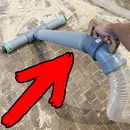Introduction: Simple Height/depth Gauge
Setting the saw blade or router bit height can be a difficult task. That is why I built this simple height gauge that also doubles as a depth gauge. I would like to share how I did it with you!
This is a really simple build that requires minimal amount of tools and materials and it can be completed in just a few hours.
This tool will make setting up process on both your table saw and router table go like a breeze. And you can also easily check depth of the cavity or hole in your workpiece. And of course, the ruler can be still used for regular measuring.
I also made a short video of the build process in case you are not so keen on text/photos.
Step 1: Tools and Materials
For this build you will need:
- Metal ruler
- Piece of acrylic glass
- Piece of plywood
- Hex bolt
- Panhead screws
The metal ruler that I used was an old one. I originally planned on cutting it in half but as the design changed during the build process I only had to slightly modify it so it is still usable as regular ruler.
The acrylic glass that I used was 2mm thick. I would recommend using something thicker as 2mm is a bit too thin and brittle.
Plywood was just regular 2cm plywood from the scrap bin.
The hex bolt should be slightly longer than the thickness of the plywood.
Tools that I used were:
- Scroll saw
- Drill press
- Router with flush trim bit
- Table saw
- Sanders
- Other smaller woodworking tools
Optional:
- Tap set
It is important to have top and bottom surfaces of the plywood flat and parallel. These should be cut on the table saw.
Step 2:
I started off by making sure my piece of plywood was square. Then I marked a shape of the body with different marking tools. I did not have a specific design. Only criteria was that it had to be tall enough to measure my table saw blade at its full height (around 9cm) and wide enough to fit over my widest router bit.
The total height should be half of what your ruler is. Leave it just a bit taller to allow fine tuning afterwards.
I used my table saw to make the straight cuts and finished the curved cut with a scroll saw.
Before moving on I also made a small cavity for the ruler right in the middle of the plywood. The cavity has to be so that the ruler sits in it flush and wide enough that it slides easily but does not have too much play. It should also be perpendicular to the bottom edge.
Step 3:
After that, I drilled a hole right in the middle of the cavity. This is where the hex bolt will go to lock the ruler in place. I also tapped the whole with my tap set but it is not really necessary as the hex bolt itself will make the threads when screwed in.
Then I just drilled holes through both acrylic glass and plywood and added the screws. It is important to use panhead (or similar) screws for this as flatheads can easily break the glass. And do not overtighten the screws!
I removed the glass and finished the outside shape on a scroll saw and gave the edges a light sanding with a spindle sander.
Next up I flush trimmed the acrylic glass on my router table . Trim down the excess glass with a scroll saw to make the routering process go easier. And be sure to wear eye protection since routering acrylic makes some nasty dust that can easily blind you!
Step 4: The Knob
The final thing to do was to make the knob to lock the ruler in.
To do that I drilled a hole in a small piece of wood and made it hexagonal so that the hex bolt would fit in. The knob itself was shaped on a disc sander. After adding the epoxy and letting it dry overnight it was ready.
I also had to slightly modify my 30cm ruler. I sanded one end so that the 30cm mark would be right on the end. I did this with a belt sander as the ruler was quite thin.
Step 5: Lesson Learned
As I mentioned 2mm thick acrylic is not ideal as it is quite brittle. I overtightened the screws and after a while the glass cracked. No worries, I made a new one and this time I hand tightened the screws instead of using a cordless drill.
I suggest you use something thicker than 2mm.
Step 6: The End
That's it!
Midway through the process I discovered that I could also use this tool as a depth gauge. Only this meant that the midpoint or "zero" would be at 15 cm. So if want to know the measurement I have to subtract 15 from the number I am reading on the top edge of the gauge.
To test it out I set my table saw blade to exactly 1 cm and made a groove in a piece of wood. I measured that groove with my gauge to make sure it was 1cm (indeed it was). And to check my results I measured the same groove with my calipers and it approved the results!
I hope my project has inspired you!
Feel free to follow me here on Instructables or Youtube for more of my projects!
Andu













